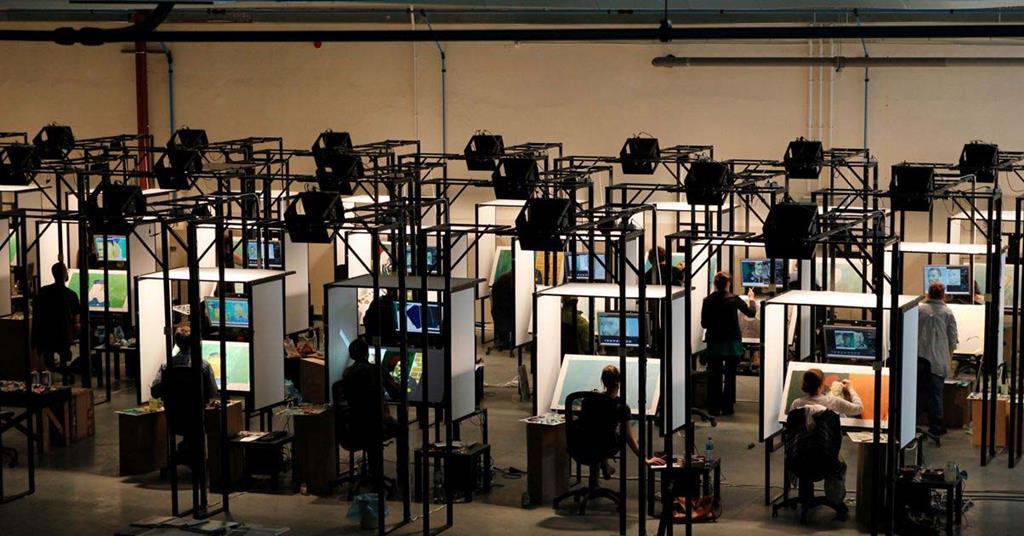Animated Analysis: Loving Vincent (2017)

Figure 1: Movie poster: https://www.imdb.com/title/tt3262342/
Loving Vincent is a historical drama created entirely with oil paintings about Vincent Van Gogh shortly after his passing. Over a hundred artists were involved in the creation of the film's frames and is the first animated film to be created entirely through the use of paintings. The budget was $5.5 million. The film was nominated for the Academy Award for Best Animated Feature. The film follows a figure known as Armand Roulin, who is carrying a letter to Theo Van Gogh, the brother of Vincent, and subsequently embarks on a journey to discover the circumstances leading towards his demise. Similar to A Scanner Darkly, the film was created through the process of rotoscoping, where live actors and actresses were filmed to create footage that would act as a basis for the paintings. A total of over 60,000 paintings were created for the production. However, Loving Vincent is heavily influenced by the painting style of Van Gogh and uses his defined art style, whilst A Scanner Darkly used a more life-like approach to its animation where the actor's likeness were always retained. Here, each of the actors are more transitioned to the environment created through the paintings, and the only actress I could truly recognise was Soairse Ronan.
Initially the director wanted to recruit artists from Poland, but had to recruit from abroad in order to produce enough frames for a full-length feature. She put up a demonstration video online, and received over 5,000 applications. Those were recruited were put through a 200-hour training process on how to animate and how to paint like Van Gogh.
The central protagonist from the film comes from "Portrait of Armand Roulin", who is wearing an ill-fitting yellow coat and is slightly suspicious of the man whose portrait he is the subject of.
The inspiration for the film came from Dorota Kobiela, who came across the last letter that Vincent had drafted to his brother whilst studying fine art in Warsaw. From this inspiration, she set to work on an animated short consistent of paintings, but after she met film producer Hugh Welchman, she was convinced to make a full length feature instead. The funding for the film came from the Polish Film Institute and a kickstarter project. The principal photography process for the film involved filming actors in a green screen studio. The animation process was done using the paint-on-glass technique, which had been previously utilized by Aleksandr Petrov, requires the artists to paint over each frame on the glass. The animation is comparable to stop-motion in that is a painting coming to life, which gives an invigorating feeling. Whenever there is fast movement in the animation, the film utilises motion blur on the subjects in frame in order to mimick reality more closely.

Figure 1: Artists painting frames for film: https://www.screendaily.com/features/loving-vincent-the-story-behind-the-worlds-first-fully-painted-film/5124673.article
The narrative of the film is intercut between two different time periods, each distinguished by their colour schemes. The past footage is distinguished by its black and white colour scheme, whilst the present tense footage has a colourful art scheme. The animation has a rustic beauty in that you can see the flicker of the lines in the frames, and this gives an indication of the process involved. A more refined animation would have kept the lines consistent. The black and white footage appears to resemble life more closely as the colourful present scenes have a range of colours not normally associated with reality. The film has been created with this art style to immerse the viewer in the world in which Van Gogh was influenced and created, and whose impact could be seen long after his death. It enforces the notion that this was a different time period from the one we currently inhabit and has different sensibilities, and so the painted frame aesthetic is appropriate for the film's internal logic.
The sequences shot at night have a more washed colour scheme, which indicates to me how important the lighting was to the footage with regards to how it influenced the colour scheme. This is notable because of how Van Gogh's painting were usually very overlit, whereas the lighting here had to be more lifelike, especially given the lack of artificial light in the time period.
The rigorous nature of the production is relevant because of how Van Gogh was known for pushing himself to extremes to achieve his artwork. The thick layers of oil paint on the canvas are remiscent of the artist's painting style known as Impasto.
The themes present within the film include depression, deceit, mystery and artistry, and the film contributes to the perspective of those themes through its utilisation of the paintings, as well as through the black and white retrospective scenes that are reminiscent of a noir murder mystery.
At the end of the film, the credits start with details of the filming locations for the live action elements, recognising the importance that live action footage has to rotoscoping, as well as stills of how the actors were used as reference for the characters.
IMDb. 2017. Loving Vincent (2017) - IMDb. [online] Available at: <https://www.imdb.com/title/tt3262342/trivia/?ref_=tt_trv_trv> [Accessed 4 October 2022].
Mansky, J., 2018. How the Creators of Loving Vincent Brought the First Fully Painted Animated Film to Life. [online] Smithsonian Magazine. Available at: <https://www.smithsonianmag.com/arts-culture/how-creators-loving-vincent-brought-first-fully-painted-animated-film-life-180968210/> [Accessed 4 October 2022].
Giardina, C., 2017. How ‘Loving Vincent’ Created the Animated Film in Van Gogh’s Iconic Style – The Hollywood Reporter. [online] Hollywoodreporter.com. Available at: <https://www.hollywoodreporter.com/movies/movie-news/how-loving-vincent-created-animated-film-van-goghs-iconic-style-1067364/> [Accessed 4 October 2022].

No comments:
Post a Comment